untitled (moon in clouds) 2004
June 2004 Archives

The story appeared in The City section of the NYTimes on Sunday. It was part of an article describing the history of the World Trade Center site. As I read it I felt that its outline seemed very familiar. It described the manipulation of the power of the state for personal gain, but while both the profit and the loss associated with two years of warfare against the Indians in New Netherland was on a much smaller scale than that of the imperial Bush wars, has anything changed much in four centuries?
Jan Jansen Damen, who came from Holland around 1630 to help set up the new colony, was more than just a simple farmer. The first European owner of what would later become part of the World Trade Center site had much greater ambitions.We won't be so lucky with Bush's name.Like an early Donald Trump, Damen had a thirst for land and wealth. He pushed aggressively to secure commitments from the Dutch West India Company for grants or leases of property located just north of the barricade that was Wall Street. Below this barrier was all of settled New York, the land where the pioneers had built their crude, wooden-roofed homes.
When trouble came in the form of Indian attacks on settlers, the Dutch governor turned to Damen for advice, naming him in 1641 to New York's first local governing board, known as the Twelve Men.
The board's chairman, David Pietersen De Vries, urged Gov. Willem Kieft to be patient, as the tiny colony, with little in the form of arms or soldiers, was vulnerable and "the Indians, though cunning enough, would do no harm unless harm were done to them."
Damen did not agree. His land, at the edge of the settled area, was particularly vulnerable. In February 1643, accounts written at the time say, Damen and two other members of the Twelve Men entertained the governor with conversation and wine and reminded him that the Indians had not complied with his demands to make reparations for recent attacks. "God having now delivered the enemy evidently into our hands, we beseech you to permit us to attack them," they wrote in Dutch, in a document that survives today.
DeVries tried to calm Governor Kieft: "You go to break the Indians' heads; it is our nation you are about to destroy." But the governor disagreed. It was time, he resolved, "to make the savages wipe their chops."
The assault, which took place about midnight on Feb. 25, 1643, in Jersey City, then called Pavonia, and at Corlears Hook, now part of the Lower East Side, was an extraordinarily gruesome affair. "Infants were torn from their mothers' breasts and hacked to pieces," DeVries relates in his journal. Others "came running to us from the country, having their hands cut off; some lost both arms and legs; some were supporting their entrails with their hands, while others were mangled in other horrid ways too horrid to be conceived." In all, more than 100 were killed.
The region's Indian tribes united against Governor Kieft and the colonists. Damen was nicknamed "the church warden with blood on his hands," and expelled from the local governing board. The governor was ultimately recalled by the Dutch. The colony, over two years of retaliatory attacks, sank to a desperate state."Almost every place is abandoned," a group of colonists wrote to authorities in Holland in late 1643. "We, wretched people, must skulk, with wives and children that still survive, in poverty together, in and around the fort at the Manahatas, where we are not safe even for an hour whilst the Indians daily threaten to overwhelm us."
Damen died about 1650. His heirs sold his property to two men: Oloff Stevensen Van Cortlandt, a brewer and one-time soldier in the Dutch West India militia, and Dirck Dey, a farmer and cattle brander. Their names were ultimately assigned to the streets at the trade center site. Damen's was lost to history
Note: The native American peoples in Manhattan were of the group, Lenape or Lenni-Lenape, later catagorized by the Europeans as Upper Delaware.
[image from RootsWeb for Montgomery County]
untitled (South Cove lights) 2004
PS1 and the members of Young Architects Program, responsible for the beautiful courtyard installation, should be delighted to know that the visitor pictured above, relaxing in one of their outdoor spaces, had made the art very much his own for part of the day. (We remembered seeing him earlier inside, very intent upon the work in the Special Projects and Studio Program rooms, but he may have been inspired by the sandy images in Ugo Rondinone's beautiful installation, "Sleep.")
I nearly forgot to post something about our visit to PS1 on Sunday afternoon. We almost didn't make it at all, since neither Barry and I nor our friend Karen were anxious to get the early start our day's ambitions recommended. We started out with a pilgrimage to ATM Gallery in the East Village, hours before the current show was to be taken down. Half of the afternoon had evaporated before we squeezed into the crowd drawn to Long Island City for the Museum's summer show, "Hard Light."
It was a warm urban moment. Summer in the city. People were drawn by the art and maybe the music, but perhaps more than anything else, by each other.
We will have to return to get a good look at the work of some 40 or 50 artists and collaboratives installed in and around the rambling old school building, but judging from what we did manage to see, I'd say that anyone would have to be quite dead not to be delighted, surprised or challenged by much of what's there.
The weekends on Jackson Avenue are great fun, but the weekdays are probably better for serious arties.
arties and friends having fun in the main courtyard on Sunday
untitled (from Wagner Park railing)
But this is not the only thing which separates us from the rest of the country.
Peter Corrie untitled (2004) 11" x 14"
Barry and I actually stopped by twice on Saturday at the Dumbo space of the TAG Projects show, "Death to the fascist insect that preys on the life of the people." We left in triumph with the piece shown above, by the young artist and curator of the show, Peter Corrie, and we still expect to add one or more small works by other artists to our cart once we can pin down the details.
There was a great deal to like about each of the dozen or so artists who had contributed work. While certainly and unapologetically politically-driven, this is art which can stand very strongly on its own both at this moment and in the eden for which these people are working.
My most-savored (or at this moment most-remembered) images are, in no particular order, the wall installations of Noah Lyon and Peter Corrie (who can't stay on paper alone). Corrie's provocative sculpture, "Dear W," is a small found suitcase filled with a simulated bomb assembled largely from art supplies. The infernal machine would be in our apartment at this moment except for the problem of space associated with most sculptural and installation art.
John Jodzio's imagination could make any neighborhood a legend, and his two large exciting works on paper (sharpie pen and watercolor) do a very good turn for Jersey City.
Leah Meyerhoff's (triptych-y?)video, "Packaged Goods," seems to offer one proposal for dealing with the fascist world of the show's title, and it's as painful as it is fascinating to witness. Great installation.
Alex Barry's 19 drawings, each assigned a title beginning with "I Wish I was . . . ," hold back as much as they deliver. I'm trying to say they're all keepers.
Drew Liverman presented a beguiling collage assembled with cut-outs from printed vinyl inflatable toys. As far as I could determine, the piece offered less menace or malice than any other in the show. So, is that something like a reversal of the kind of impulse which will sometimes contrive a deliberate mistake in an otherwise perfect work?
Jeff Swartz creates small, pretty, exquisitely-crafted melancholy images of military hardware.
Tim Kent has refashioned a child's doll (ok, it's actually G.I. Joe), and its labelling, and returned it to its bubble-wrap packaging. The figure is now costumed as the standing, black-hooded figure in Abu Ghraib Prison which will be etched in our brains forever.
Spy pins a home-made stuffed white rabbit to a column and in its "hand" are three useless playing cards. Just below the figure is another, separate work, a white marker image on black paper of the devil holding a rabbit upside down. The title of the piece with the stuffed rabbit? "He's Got Jack."
We're very sorry once again that we only managed to get to the gallery space on the last day of a one-week show run. We'll do better next time, and I certainly hope, and expect, there will be lots of nexts. We want to watch this good stuff happening.
Noah Lyon drawings, installation detail
Peter Corrie Dear W (2004) mixed media 3' x 2' x 4'
Drew Liverman untitled (2004) 6' x 4' printed vinyl & plastic sheeting
Spy, installation view, with He's Got Jack (2004) 2' x 1' fabric, stuffing and playing cards; and untitled (2003-2004) 14" x 11" marker on paper
One more note about both the people who are TAG Projects and the artists shown in this exhibition: Many if not most of them are as dedicated to and creative in music as they are in their visual work.
And if anyone's still wondering about the inspiration for the title of the show, copied in the first paragraph above, it's a quote from the Symbionese Liberation Army. For more of an immersion in extreme activism, and only slightly less extreme sex, check out Bruce LaBruce's new film, "Raspberry Reich," a brilliant film tool for seducing homos on behalf of the revolution.

the United States Supreme Court, showing nothing upstairs
More on today's ruling from the Supreme Court.
The news stories which first appeared this morning have already been rewritten a number of times (the AP story I linked to in my own post no longer exists; its replacement bears a report which is almost a reversal of the original), reflecting the confusion which surrounds the justices' "decision."
I think most of us don't have to be reminded that it was this same Supreme judiciary body which three and a half years ago installed the Administration which we see working so asiduously to re-create the remainder of the judiciary in its own image.* I don't think we can expect "judicial review" to safeguard any of us from assaults waged in the name of the War on Terror.
Today's decision says Bush has the right, under the Patriot Act, to arrest and hold both citizens and non-citizens indefinitely and without charges, although both citizens and non-citizens have the right to go to court to argue, apparently one at a time, that in their particular cases they are being held illegally. No one will be let out today - or tomorrow - and in fact the separate cases could be argued for years while the plaintiffs languish in camps, thanks to these (un)worthy judges.
However you look at what the Court did today, it has to be regarded as making bad law.
* One reminder which more of us actually do need: John Kerry, our great blue hope, voted for the war, voted for staying the course in Iraq, and voted for the Patriot Act.
[image from supremecourtus]

Chaplin in "The Dictator"
We have no freedom.
I'm looking for the nearest door.
[image from DVDMaXX]

Big Time
Could this be the same newspaper whose editors have been major cheerleaders for the Bush administration for three and a half years? Starting even with their site headline, "Cheney Uses Major-League Expletive," this delicious story from the Washington Post reads more like something you'd see on a smart progressive blog than what you might expect from a White House rag.
Among other helpful tips, the Post article reminds us:
As it happens, the exchange occurred on the same day the Senate passed legislation described as the "Defense of Decency Act" by 99 to 1.Goodness!
[image from CONSPIRATION.CC]
A few quick shots of four shows enjoyed very recently, the first two in high Chelsea, the last two in lower Williamsburg:
Ryan Humphrey installation view, including (top to bottom, left to right, BMX for Japanese Hipster (Aztec Orange), BMX for Japanese Hipster (cavern Pool Green), Remember, Narrate and See (all 2004)
At Caren Golden Fine Art Ryan Humphrey shows a very personal selection of already playfully-seductive commercial products which he has intensely, even obsessively, individualized. They end up as the things without which the rest of us simply cannot go on. It looks like he started working on this show when he was seven - and I mean that in the best way.
The show has been extended through July 16.
Freecell, installation view
The collaborative Freecell is responsible for what may be both the most charming and most disturbing installation around this month. When you enter a small quiet room at Henry Urbach Architecture you are in a spaceship hovering among an unnatural miniature landscape where impossibly-high real skyscrapers are visible just outside the vessel's large window. The environment is both abstract and, quite literally, very earthy, er . . . mossy. The conceptual implications end up mucking up your head even after you've returned through the air and time lock and travelled back to where you began.
While you are there, don't miss the other side (in both senses) of this brilliant gallery, an elegant show of architectural photographs by Ezra Stoller.
Susan Jennings installation view Wood Corner (2002) c-print, plexi 26-3/4" x 26-3/4" courtesy of Michael Steinberg Fine Art
Nancy Shaver The Blue And The Gray (1989) antique frame with found clothing 37-1/4" x 23-1/2 x 3" courtesy of Feature Inc.
Jennifer Coates Adrift (2004) acrylic on canvas 30" x 24"
Champion Fine Art just took down their "Exhibition #14: Grass and Honey," curated by David Shaw, and it was up to the very high standards of an artist-curated series which began with #20 and which will end as it winds down to #11. The last ten exhibitions will be mounted in Los Angeles - our loss, the Angelenos gain. There were two fine works in this show by Susan Jennings, each photo-based. One jumped into the third dimension, all be it only one plane at a time.
Also within the space through yesterday, the Nancy Shaver and Jennifer Coates pieces were as striking as they are "photogenic" themselves.
William Powhida installation detail
William Powhida installation detail
You've probably seen him everywhere, and you've certainly read his work, now you get to see William Powhida's very personal art at Dam Stuhltrager gallery, on a small corner in Williamsburg, just west of the BQE. The title of the show, "Persona," doesn't begin to suggest how many of his roles you'll find there. The wonderful video in the special "back room" in the middle seems almost to hold it/them together - if only for its (eminently-repeatable) four-minute duration.
untitled (Roebling street tree)
I have a certain awe and respect for the hibiscus, although I've never lived with one. My fascination began long ago in Oshkosh on my Aunt Lillian's veranda and it was renewed soon after I first discovered the formal summer plantings above the Swan Boats dock in the Boston Public Garden. A glorious hibiscus "tree" stood at the center of a fascinating group of trailing and spikey plants in one of those giant iron Victorian urns popular at the turn of the 20th century.
The hibiscus always seemed to me to be a survivor from an earlier, gentler time, and it certainly had no place in the horiculturally-challenged garden of my mother's house. It also seemed to be both exotic and surprisingly ordinary, depending upon which of its parts were being observed. Above all, it wasn't the least bashful about its colors, and I loved them all.
Apparently Andy did too. I only realized recently that the Warhol image which probably most rivals that of the soup cans for its familiarity was inspired by the same hibiscus which decorated both Aunt Lillian and Boston.
The yellow specimen in the photo above was waving to me this afternoon from the edge of the sidewalk as I walked pass my local florist on 8th Avenue. I immediately captured it with my little magic camera, but I went inside to ask if there was a chance it would survive in the microclimate of our roof garden. The shopkeepers were encouraging, but a quick Google at home persuaded me it would be an impossible relationship.
Fate keeps me from living with either Warhol's hibiscus or the living original, but it's left me this image.
We dropped ourselves off inside the Drawing Center's "Playpen" Wednesday evening, where we bumped into some old playmates and made some new ones. We had a great time and left only after promising ourselves we'd be back another day - with others.
There are a dozen artists represented in the show, and fully half of the environments they have created are designed to be altered - by creative visitors or the artists themselves - so no return visit will be quite the same.
It's a perfect summer show, but that doesn't mean you'll have to shut down any heavy aesthetic sensors or sophisticated brain cells to enjoy it. They will all be rewarded. Besides, The Drawing Center has AC, so there's nothing to keep you away.
The artists included in the show (and, in one case, beyond) are David Brody, Voebe de Gruyter, Charles Goldman, Alina Viola Grumiller, Valerie Hegarty, Geoff Lupo, Edward Monovich, neuro Tranmitter, Red76, Gedi Sibony, Austin Thomas and Alex Villar.
Just a hint of what we saw on Wednesday:
Valerie Hegarty's shedding bedroom, or at least much of it
Austin Thomas's art classroom, with Shoshana Dentz, Joan Linder and Charles Goldman
Gedi Sibony's assemblage (detail)
Edward Monovich's images with purposed graffitti process well under way
Charles Goldman's corner (detail, and subject to continuous alteration)
Charles Goldman's installation was especially tempting that night. Even though I was already balancing a camera and a conversation I was compelled to move one of his drawings (his "dingers") from the table to the magnetic board on the wall. Below is an image of the table (the blur represents a kid who really got into the creative process) and then one of Barry, just after he announced, "these are too lined up; it's bugging me."
live "dancers, whores, merrymakers, and priests" outside powerHouse Books (the few "corpulent Weimar German types" to be seen last night were inside by the snacks and bubbly, but since they were there, they were obviously on the side of the republic)
Three years ago Larry Fink completed the film shoot, and the pictures were scheduled to run in the NYTimes Magazine in the Fall of 2001 as an arty fashion spread with a bit of frisson. There they would probably have attracted a modest amount of attention.
Then the world seemed to stop. September 11 may not have changed everything, but it certainly frightened the Times, and, as it turns out, apparently every other periodical market in both the U.S. and Europe.
The tableaux vivant produced in the summer of 2001, with their voluptuous, polychrome sculptural presence, have become forbidden pictures.
Fink has been unable to persuade any magazine to print these remarkable photographs. powerHouse Books is now publishing them and they are currently visible at their gallery on Charlton Street, where they will remain through the last day of the Republican Convention, September 2. The Gallery calls them, "a provocative political commentary" and "a satirical look at Americas current leaders."
The artist tells us a little more.
It was simple! I was shooting fashion, perhaps a compromise for me, but a trivial, jovial, stylish, learning theater. Why not use its public accessibility for subversion, satire, association, and education? An idea! One of my favorite periods in twentieth-century art was Weimar Germany, with Beckmann, Dix, and Grosz all melting down convention in an impassioned visionary way. Grosz was especially political, but all of the were hyper-aware of the decadence, the despair, the hysteria, and the lies. I suggested to The New York Times Magazine (whose rear end is sometimes gifted with fashion spreads) an idea to replicate the period but loosen it, update it, and tell it anew. There were fashion equivalents and certainlymoral and historical ones.These are the pictures. But don't expect credits for the fashion.Oh the glee! They said yes. I suggested that rather than the corpulent Weimar German types, why not use our current fraudulent leaders, George W.and his cabinet. Oh the glee! They said yes. Political satire and critical acuity are something rarely if ever done in fashion. Yet another coup.
We searched for the cast of dancers, whores, merrymakers, and priests. We searched for the look-alikes of our own Mr. G. W. and his consortium. We found it all and went to work. Five paintings chosen from the period and three days shooting them, interpreting them, and creating aesthetic clarity and political bedlam.
The pictures were shot on 7/19/01 and were hypothetically scheduled to run in The Times in the fall. 9/11 gave birth to doom. The tragic inevitable moment, the rupture of providence, the rape of the external soul of America. And its aftermath. [excerpt from the Artist's Statement]
the press conference across from Madison Sqare Garden ended, some participants still linger [NY1's Michael Scotto in front, Donna Lieberman of the NYCLU in the center, and from UFPJ, Bill Dobbs, back to camera, tall on the far left and Leslie Cagan, partly obscured, fingers spread, on the right]
Beginning last June United For Peace and justice (UFPJ) started planning a New York City march and rally for August 29, the eve of the Republican Convention. They still have no permit.
In fact, no police or park permits have been granted to any of the organizations planning protests related to the Convention, although some applications were made up to a year ago.
UFPJ has filed an application for a permit to walk up 8th Avenue from 23rd Street, past the site of the Convention, Madison Square Garden, and end up with a gathering in Central Park. The NYPD and the NY Parks Department wants them to go to Queens for their rally or, alternatively to bake in the wasteland of the West Side Highway, four long blocks left of the Convention site.
Today a number of groups planning protests related to the Convention joined UFPJ in a press conference across the street from Madison Square Garden, to describe their frustrations with city agencies and to demand that Mayor Bloomberg protect their right of dissent.
We should all be concerned with what the experience of these groups says about the agenda of the Bloomberg administration, bending over backwards to see that the convention of a radical right-wing political party goes as smoothly as possible, while doing absolutely nothing to ensure the peaceful assembly of those who wish to voice objection. Should this surprise us at a time when the Republican party controls the mechanisms of all three branches of the federal government as well as Albany and our own City Hall? Now even dissent must be eliminated or at least rendered invisible.
Even beyond the big issue, the city's behavior is appalling for what will be its impact on the basic safety of both New Yorkers and visitors in the last days of what will surely be a long summer. We should be asking how are the best interests of anyone being served when no group knows how to plan for August 29, neither a police department (already being stretched to the limit by real or imagined security concerns) nor a crowd whose size some now expect may easily end up as a seven-figure number. The city is playing a dangerous game, and we are the pawns.
Virtually every other great city of the world (and I won't even use the customary patronizing qualifiers, "western" or "industrial") can accomodate enormous peaceful protest without confining participants in pens or moving them far beyond the periphery of protest targets. But in the land we call "of the free" we only imagine we can exercise such liberty, and it's some measure of just how unfree we are that few understand that they are are so bound.
The right to dissent and the right to protest are meaningless if the dissent and protest are neither heard nor seen.
On August 29 we gotta pass by the Convention site, and we gotta have the Park.
Tony Smith The Elevens Are Up (1963) steel, painted black, two units, each 96" x 24" x 96" and overall 96" x 96" x 96"
This stuff thrilled me in the 60's, even before Kubrick, and it still does.
At Matthew Marks, in the space upstairs on 24th Street, there's a minimal installation of minimal Smith. It'll be there for two more weeks.
CORRECTION: I was wrong in my original posting; Tony Feher's show continues until Friday, July 2. Also, I've just added descriptions of the two works shown below which were not identified earlier
I was wrong. Tony Feher's really wonderful show at D'Amelo Terras didn't close on Saturday; It was always scheduled to be up through Friday, July 2. So, while I can still throw images of some of my favorites out into webland, those of you who can get to the neighborhood can go see the beauties for yourselves.
This stuff is magic, and not just because it makes absolutely everyone smile, a lovely art of which we can never have enough.
Tony Feher Untitled (2004) nine stacks: forty-six glass jars and lids; dimensions vary with installation - approx. 33" x 27" x 17"
Tony Feher Believe in the Way Things Are (2004) wire hangers, plastic straws, plastic wrap, candy wrappers, magnets, string; dimensions vary with installation - approx. 48" x 75"
Tony Feher Mountain Home (2004) 140 green plastic fruit containers; approx. 26 3/4" x 30 1/2" x 20"
I was in the garden most of the afternoon. No, not the wonderful wild tundra of the High Line represented above, in a picture taken Saturday afternoon, but the 12' x 16' roof which lies outside our apartment.
New Yorkers have many gardens, and almost all of them are communal property. Chelsea however has no real public park, so Barry and I consider ourselves fortunate indeed. We have both the luxuriant garden court of our building, and the far smaller, and far less light-gifted, accidental Eden immediately outside our own walls.
I would describe the exposure outside our second-floor, north and east-facing windows as very deep shade. That's the environment many of us remember from our childhood as the one which accounted for the cement-hard, packed ground lying under the largest shade tree in the neighborhood. Even the ferns and the Lilies-of-the-Valley couldn't make it there.
I've been defeated repeatedly in my attempts at bringing a woodland environment to the perimeters of our urban shelter, but, partly thanks to a little past experience with limited resources, the undaunted Linda Yang and the Chelsea Garden Center, I haven't given up yet.
Pictures will follow, as soon as the latest plantings establish themselves. I'm convinced that's going to happen, or I wouldn't already feel exhilarated by this afternoon's work in "the garden."
The High Line? Looking at these pictures, it's hard not to ask that it be kept exactly as it is. New Yorkers should all be able to run through a meadow, even if much of the horizon is composed of second-story windows.
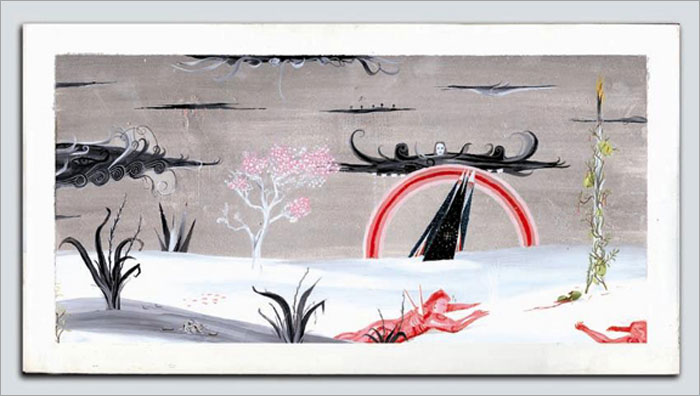
Eliezar Sonnenschein Emet (2003) acrylic on wood, 15.25" x 26.75"
Barry and I began the evening on Thursday [see the two posts below] with a stop at the opening of the invitational exhibition, "Sommer Show," at Lehman Maupin on this side of the East River.
We have eagerly visited the booth of this Israeli gallery, Sommer Contemporary Art, every year at the Armory Show, so we were very happy for the director, Irit Mayer-Sommer, when we saw the brilliance of what I believe is her first show in New York.
I thought Eliezer Sonnenschein's acrylic panels on wood were magnificent gems, but I'm certain that someone(s) with deeper pockets than mine will soon be carrying the three home. Sigh. They can't really be seen in something like the reproduction used above.
I also think a lot of Yehudit Sasportas's large ink marker drawings. Sharon Ya'ari's large black and white photgraphs of spaces vacated by the strange people they serve, inspired by minimalism, minimally presented, would stand out in any company. Rona Yefman's direct but sensitive color and black and white portraits are not easily forgotten.
All of it the work of excellent Israeli artists, this art would stand up in the crowd anywhere in our connected world, and its substance makes it especially clear that it wasn't created in a bell jar.
This beautifully-mounted show is extraordinarily welcome at this time in a city which really wants to believe in something other than the current, pervasive wave of fear and hatred incited by the small minds and empty hearts of the artless.
[image from Lehmann Maupin Gallery]
A number of the workspaces tempted us during our visit to Smack Mellon's Open Studios Thursday evening, in adition to that of Valerie Hegarty. We were especially intrigued by the work of Shin il Kim, Andrea Loefke and Austin Thomas.
We'd seen the amazing videos of Kim at Axel Raben's Paper Chase show last April, and Austin Thomas's constructing presence is difficult to avoid anywhere in New York these days. (But, damn, I still haven't seen the neat folding outfit she created for that fantastic Ford El Camino of hers!). Finally, while I think this was the first time I'd seen any of the elements of Loefke's delightful, exploding world, I'm sure it won't be the last.
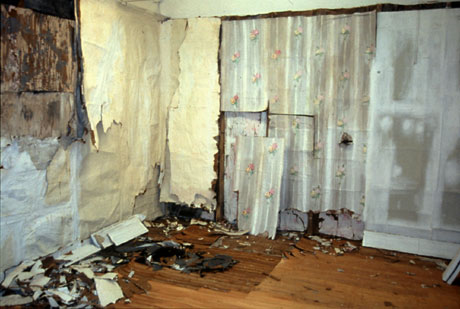
Valerie Hegerty Renovation (2002) paper, cardboard, paste, paint, 8' x 14' x 14'
As soon as I walked into Valerie Hegarty's studio I thought I'd died and gone to heaven.
My reaction may have been rather singular, because even I was not surprised that some visitors to her part of Smack Mellon's Open Studios weekend decided her workspace was an empty room not quite swept up yet. This was one of the confidences she shared with Barry and I last night.
But I was immediately at home, or rather immediately taken back to a previous home. At the same time I had the impression that the two successive, long-term creative passions of my life had somehow been reconciled: the recovery of a domestic architectural and social past, and an immersion in the visual art of our time.
Hegarty builds new, lovingly-assembled, homely environments, out of paper, paste and paint, which uncanily evoke the decaying remnants of, well, old, neglected, homely environments.
The real stuff has a power over me because it appears to be both untouched and touched very much, even too much. There's wear, lots of wear, and it looks fantastic, very purposeful and above all very human. Hegerty's imaginary recreation of such (ephemera?) is obviously stimulated by a great love of and serious commitment to the spell of such (almost) spent human environments. The product of her art raises to a level just this side of the sublime what once could only be part of the real world.
I crept about the studio half holding my breath, but then, when we both introduced ourselves to the artist, we were soon even more intrigued than before. I'm afraid we ended up monopolizing her attentions unfairly.
I told her about my fascination with the unselfconscious physical dignity of old buildings and with their previous lives. My interest began when I moved to grad school in Rhode Island, and it quickly became something of an obsession. Feeding such a passion was easier in the period I was there, 1964-1985, since I was able to crawl into abandoned townhouses, mills, churches, warehouses, shops and farms still undisturbed by modern remodeling, "restoration" or arson. I was like entering long-abandoned Egyptian tombs.
In those days architectural artifacts were regularly tossed as trash, even in neighborhoods already being "discovered." During that time my partner and I were able to save one modest eighteenth-century house from disaster. Disguised in filfth and layers of paint, wallpaper, flooring and siding, sweat and imagination eventually made it look like it had only been heavily worn during its 250-year life. And then we each abandoned it, ultimately to owners who would love it but never know the joys of our own discoveries along the way.
Hegerty's creative response to that environment came much later, and from a very different direction. Also a New Englander, she grew up in Massachusetts, but her own parents' home, faux-colonial, could only sadly reference the integrity of its sturdy, hoary neighbors. Plastic ornament stood in for the kind of artifacts I saw thrown to the trash pickups.
But wonderful art followed.
One of the treats we were able to walk away with on Thursday was the revelation that she has been working with playfull storyboards to (perhaps) move, into the dimension of film, an aesthetic which even now is hardly limited in the way it provides enjoyment. Her art works as both realism and abstraction, both painting and sculpture. I stopped for a moment to imagine a delightful projection of flesh and blood people appearing in, disappearing into and altering her remarkable synthetic environments. More magic.
The Open Studios continues tomorrow, from noon to 6pm.
If you miss it, you have another chance to see her work very soon. Hegerty is one of twelve artists selected to create site-specific environments in the show, "Playpen," opening at the Drawing Center on Wednesday. I wouldn't miss it for the world, especially as the list of artists also includes Charles Goldman, Austin Thomas and Gedi Sibony.
[image, of an instalation not in the studio of course, from Smack Mellon]
untitled (Madison Park pansies)
Grand Central Station
waiting for the Lex express
on board, somewhere above Union Square, er . . . actually, below
transferring to the L
I saw the message captioned, "Photographer's Rights Protest," and I told myself, "I'm in!"
The issue is the New York MTA's recently-announced proposal that photography be banned throughout the system. Of course it would be for our protection, from camera-hefting researcher/terrorists. I was attracted to the issue (how could its lack of merit even be arguable?), but the fact that a demonstration was announced through the internet, the modest panache of its text appeal, and finally my own recent experience with MTA security incompetence, and its photographic documentation, made it a must.
An excerpt from the organizers' webpage:
This will be a peaceful demonstration against the MTA's proposed Photography Ban, conducted in the spirit of Rosa Parks. We will simply ride through Manhattan with our cameras, taking as many photographs as we please, of whatever we please. This is a completely legal protest, as photography within the subway system has not yet been banned (even though the police seem to have been told otherwise).
Participants were asked to bring cameras and, if they wished, "a witty sign." I have to admit that while I had good intentions, I didn't manage to fabricate the cool sandwich-board I had created in my head; I went shamefully textless. So did all but one of the hundred or so people who gathered in the central hall of Grand Central Station early this afternoon. That singular body sign, "the end is nigh," was suitably wry but undoubtedly arcane for all passers- and sitters-by.
But maybe in this action it really was appropriate to just take pictures, especially if the press was already interested, as it seemed this afternoon it was.
The weirdest thing for someone who's been in perhaps hundreds of other zaps and demonstrations was to be in the midst of all these people taking pictures of each other. Right now there must be thousands of shots out there somewhere showing people snapping people snapping people snapping people, and perhaps beyond.
Not incidently, our progress through the system today must represented the safest time and place in the history of the MTA - at least as far as any threat originating with camera-wielding terrorists is concerned. Don't leave those cameras home, good folks; it's for your own security.
For some early-posted, great images go to the dart board]
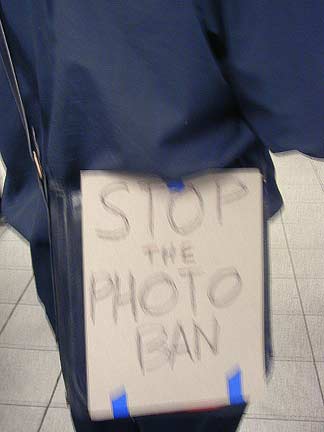
In the end, I broke down and made this crummy impromptu sign on the site, hoping it might raise us above the "flashmob"-type thing.
[bottom image from Forgotten NY]
The NYTimes begins its obituary of Ronald Reagan today with a three-column headline on the front page and it continues inside for a total of four more full-page sheets uninterrrupted by advertising. The size of this death notice may be unprecedented, but the most newsworthy item is what's missing.
The words AIDS or HIV do not appear once.
This is beyond politics; it's criminal neglect, if not part of a deliberate agenda, from the newspaper which was itself so guilty in ignoring or mishandling accounts of the plague during the Reagan years. Now that same newspaper would have us regard as serious journalism its account of the life of our second-most-disastrous president, the man whose administration, in surviving its general malfeasance and treasons, marked the final disintegration of American democracy.
We won't buy it.
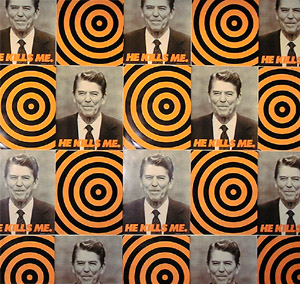
Donald Moffett He Kills Me (installation detail), 1987
He's dead, but as the encomiums pile up he's not going to look dead enough.
Reagan virtually spat on people with AIDS throughout his presidency. The epidemic began under his watch, and he ensured that it would ultimately kill millions. For that responsibility alone, he didn't deserve the relief alzheimers must have brought to his memory.
Ah, wait, Barry just turned on Sylvester's "You Make Me Feel Mighty Real." The magical musical legend Sylvester died of AIDS in 1988, so that ecstatic, triumphant shout of delight seems very real around here today. We're dancing on his grave tonight. Maybe me especially. I'm still talking, and now that monster/fool is not. I'm one of the lucky ones. I've been HIV+ for decades, and I'm not leaving yet.
Oh yes, and my memory's just fine.
[image from Richard F. Brush Gallery, St. Lawrence University]
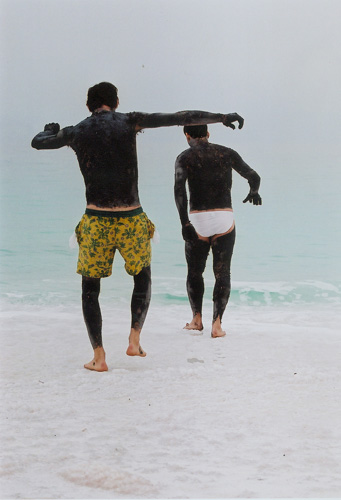
German visitor and Israeli tour guide meet the Dead sea
I'd say that Eyton Fox has now redeemed himself in the eyes of anyone who might have thought his last film, "Yossi and Jagger," operated in too much of a bell jar. The story of a love affair between two young Israeli officers in a remote army base on the Israeli-Lebanese border, "Y&J" does not really address the elephant in the barracks - the moral questions of occupation and violence.
The American-born Israeli fimmaker's third film, "Walk On Water," which premiered last night at New York's NEW FEST, is a much more mature film than the very well-received feature shown by the director last year, and it covers far more ethical ground without stretching the moralizing. The film's most profound voiced statement is brief. It's delivery is given to an Israeli Arab and it's directed at a Jewish Israeli who represents absolute power in their shared world. The young Arab, his family and his nation have just been deeply insulted in front of two visiting young Germans. His reply, painfully gentle under the circumstances, is directed into an open car window. It was something close to this: Maybe if you people could get over what happened to you a long time ago, you'd be able to see what you yourselves are doing now.
It's a wonderful, nuanced film. It's about all kinds of people doing both very bad and very good things, representing the relationships between one generation of Palestinians, two generations of Jewish Israelis and three generations of Germans. No one gets off easily.
Now what some of you will appreciate knowing before you decide to go: The actor playing the lead Israeli character, Lior Ashkenazi, is one of the most beautiful men ever touched by a camera.
[image from the film's website]